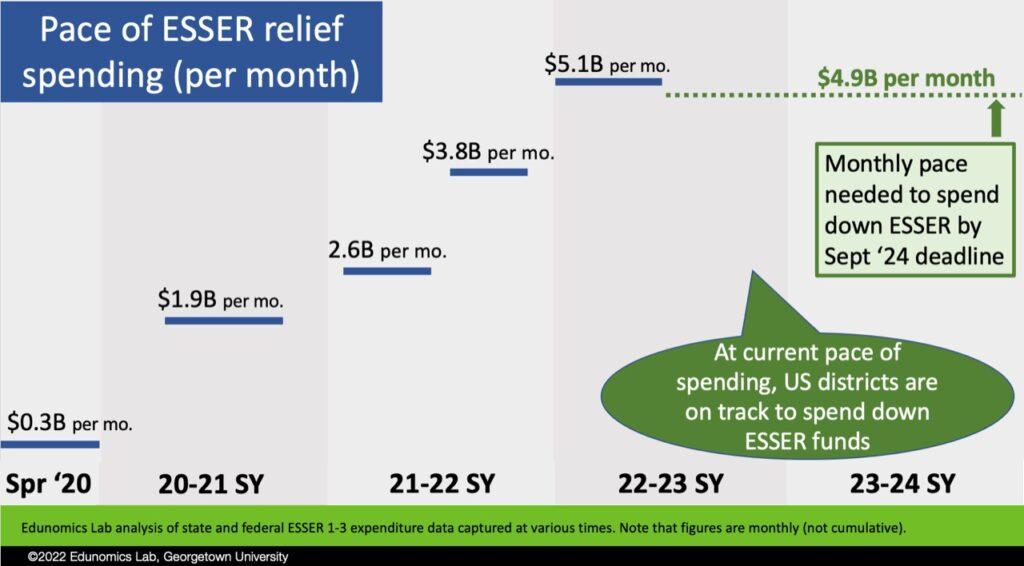Georgetown University researchers published the most recent data from their study tracking school districts’ implementation of funding from the Elementary and Secondary School Emergency Relief (ESSER) fund, a federal government aid program that has supported schools since March 2020, on April 4.
Researchers at the Edunomics Lab, an institute that explores education finance and its impact on students, compiled a database of how school districts in every state have allocated ESSER funding. The study predicted that given the current pace of spending, federal funds for the program will run out in September 2024.
The Edunomics Lab runs the only dashboard in the nation that tracks how school districts in all 50 states are allocating ESSER funds, according to Marguerite Roza, the director of the Edunomics Lab and a co-author of the article. The researchers’ study explores how the expenditure of funds reflects the various priorities and outcomes of school districts, with the goal of informing current and future policymakers in the education finance realm.
Roza said their study comes at a pivotal moment as schools spend larger amounts of money in the face of budget constraints as they emerge from the pandemic.
“We’re facing what we call a fiscal cliff,” Roza told The Hoya. “In a year and a half, this money runs out. Districts will have to figure out how to live on less money, and there’s inflation, so people are really struggling with deciding how much to pay teachers.”
The ESSER fund is the largest federal government program that provides funding for schools, according to Katie Silberstein, a co-author of the study and a strategic projects lead at the Edunomics Lab.
“ESSER is the largest ever one-time infusion of federal funds, and these funds were distributed to districts such that districts with larger concentrations of high-need students received more,” Silberstein wrote to The Hoya. “As our center is regularly exploring equity impacts, we are well-positioned to meet this unique moment to try to understand state and district financial decision-making with their ESSER funds and the impacts on students.”

Silberstein said she hopes the report and the study’s ongoing dashboard will help states make more informed decisions about allocating ESSER funds for the coming year.
“The hope is that states and districts will take the opportunity to assess their current and planned investments, evaluate the impact these investments are having on their students and pivot where necessary in order to make the most of the remaining federal aid,” Silberstein wrote.
The Edunomics Lab received a grant from the Bill and Melinda Gates Foundation to conduct this research, according to Roza.
Roza said ESSER funding was distributed over three waves, with the first two occurring during the Trump administration. The Biden administration oversaw the third and largest wave, which provided up to $10,000 per student in high-poverty school districts like those in Detroit and Cleveland.
ESSER funding contributes nearly $5 billion in total to education every month and will continue to do so until the money runs out, according to Roza.
Roza said the Edunomics Lab study aims to understand the outcomes of ESSER and find nationwide patterns to new spending habits.
“We’ve never had this much cash flow into the system without a whole lot of rules attached to it,” Roza said. “So I think people want to know what happened to the money, and school districts got to decide how to spend it.”
Judy Zhou (SFS ’24), a student researcher who helps Silberstein gather and synthesize data, said the ESSER study could lead to policy implications for states, school districts and students.
“The ESSER dashboard places all states’ ESSER expenditure data in one place, which creates opportunities for conversations that compare spending across states and regions,” Zhou wrote to The Hoya. “Especially after the COVID-19 pandemic, students need support and resources more than ever. The ESSER dashboard has the ability to give us a glimpse into understanding what those needs are through data.”
States cannot force school districts to spend their funding in any particular way, which results in each of the approximately 14,000 school districts in the country making spending decisions through publicly elected school boards, according to Roza.
Silberstein said states are mostly implementing the funding as the federal government had hoped they would — but these districts also exercise their discretion in many ways.
“ESSER funds were distributed with the purpose of safely reopening schools, and to help meet the academic, social, emotional and mental health needs of students post-pandemic, particularly those most severely impacted,” Silberstein said. “States and districts are meeting these intended uses, though there is wide latitude with those investments.”
Jigyasa Sidana (GRD ’23), a student research assistant on the project, said the Edunomics Lab’s study serves to connect all of these data points and identify larger trends.
“There is diversity in priorities for school level spending across districts and states,” Sidana wrote to The Hoya. “Edunomics Lab is performing a crucial role in this regard — by bringing all data together for quick and accurate analysis.”
Sidana said she hopes the lab’s ESSER dashboard will reach policymakers and influence their future decisions.
“I hope that the policymakers in the U.S. education system utilize the ESSER data analysis to make decisions regarding the ideal level and type of funding for various school needs, determine adequate reporting requirements for school districts and most importantly, ascertain how school level spending impacts student outcomes,” Sidana said.





















